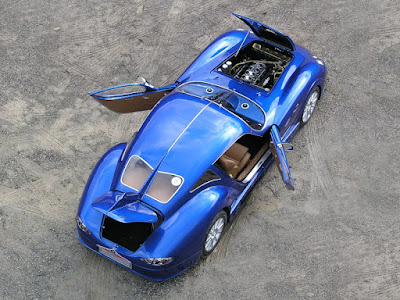Sometimes, the big-motorcycle shouldn't have to be seen from its engine capacity. But, this is huge in real sense. Have you ever imagined before if there were motorbikes as big as a truck? In general, motorbikes have a length of no more than 2 meters and a handlebar span of more than 1.2 meters.
 |
| The world's biggest motorcycle ever made called Tower Trike, with a length of 3,078 cm and weighs over 4.9 tons. (Picture from: https://bit.ly/35kpIrX) |
 The motorbikes that will be discussed at this time really represent what we will call the real big-motorcycle. Yes, the size of its body is really big! The motorcycle in question named Tower Trike.
The motorbikes that will be discussed at this time really represent what we will call the real big-motorcycle. Yes, the size of its body is really big! The motorcycle in question named Tower Trike.This is a giant motorcycle built by Jim Gesto, a truck entrepreneur who is used many of his times with large vehicles. Unmitigated, the Tower Trike Trike uses a truck chassis as the basis for its development.
As can be seen from a Youtube channel of Biker and Beards which features it as the largest motorcycle to ever run on the highway. Because of its size, this motorcycle has the size of a truck without a body, aka only the frame and engine. This monster trike is 268 cm high and 3,078 cm long and weighs about 4.9 tons. Even though it is the size of a truck, it only has one front tire, so then the American regulations classify it as a motorcycle.
The rest, this giant motorcycle also has features like a motorcycle in general, such as handlebars, mirrors, fuel tank, front driver's seat, and passenger seat, then there is also a speedometer. Uniquely, the handlebars used have a mechanism like a car steering wheel and rely on the pedals for the throttles and brakes.
In order for the monster motorcycle whose legs rely on the Air Glide air suspension to run fast, a Detroit Diesel V-Block Supercharged 6V92 engine is used as a drivetrain, which can produce 335 hp with 1,020 lb-ft of torque. The power is channeled through the Allison HT 740 transmission so that it is able to encourage this motorcycle to go up to 135 kph.
As can be seen from a Youtube channel of Biker and Beards which features it as the largest motorcycle to ever run on the highway. Because of its size, this motorcycle has the size of a truck without a body, aka only the frame and engine. This monster trike is 268 cm high and 3,078 cm long and weighs about 4.9 tons. Even though it is the size of a truck, it only has one front tire, so then the American regulations classify it as a motorcycle.
 |
| See how big the Tower Trike is when it compared to a normal-sized Harley Davidson motorcycle. (Picture from: https://bit.ly/35kpIrX) |
 |
| Like motorbikes in general, the Tower Trike also has handlebars, mirrors, fuel tank, front driver's seat, and passenger seat, then there is also a speedometer and tachometer. (Picture from: https://bit.ly/35kpIrX) |
The modifier also added a cross-shaped iron weighing 90 kg on the back of the motorbike. In addition, said as the vehicle's aesthetics of a kind of religious symbol, it also functioned as a roll bar for riders and passengers. For those of You who call Yourself as a real-biker and like big motorbikes as well, You can have this monstrous-sized motorbike for the US. $90,000 (approx. Rp. 1.3 billion) with its building time of about a week (but not including shipping fee to Your garage).
One more thing, if You ride on this big-motorbike, You shouldn't have to be arrogant on the streets. Because the others also have the same rights as You are, while on the streets.
Kept spur your adrenaline on the power of the two-wheeled monster and
stay alive with true safety riding. May God will forgive Your sins and
so does the cops...... *** [EKA | FROM VARIOUS SOURCES | REVZILLA]
Note: This blog can be accessed via your smart phone














































